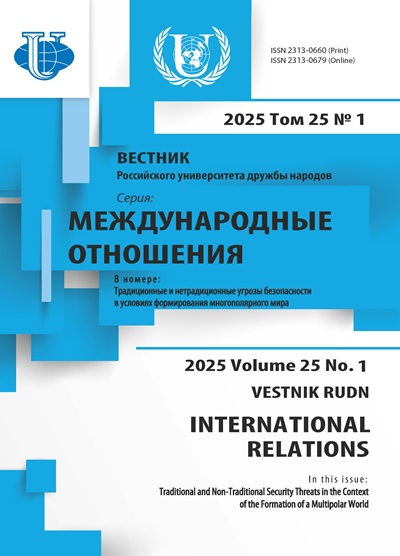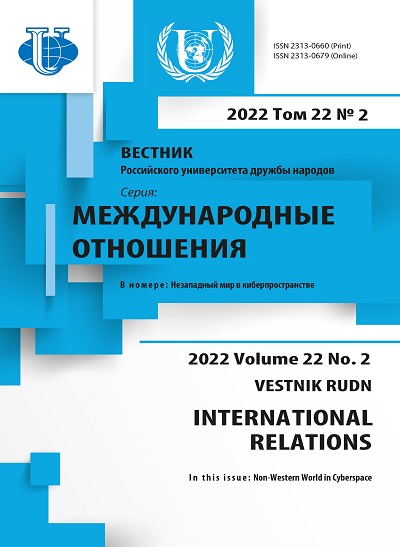Цифровой Шелковый путь Китая в эпоху цифровой экономики: политический анализ
- Авторы: Чэн Г.1
-
Учреждения:
- Российский университет дружбы народов
- Выпуск: Том 22, № 2 (2022): Незападный мир в киберпространстве
- Страницы: 271-287
- Раздел: ТЕМАТИЧЕСКОЕ ДОСЬЕ
- URL: https://journals.rudn.ru/international-relations/article/view/31407
- DOI: https://doi.org/10.22363/2313-0660-2022-22-2-271-287
Цитировать
Полный текст
Аннотация
Цифровая экономика становится все более важным фактором глобального экономического роста. Региональное сотрудничество в цифровой сфере получило ощутимый импульс в результате запуска инициативы «Пояс и путь». Цифровой Шелковый путь (ЦШП), будучи технологической частью «Пояса и пути», выступает «цифровым мостом» в продвижении нового типа глобализации. За последние годы здесь был достигнут значительный прогресс. Благодаря ЦШП удалось укрепить региональное сотрудничество в сфере цифровой экономики, в частности в Азии и Африке, через трансграничную электронную торговлю и мобильные финансовые инструменты. ЦШП отражает глобальные технологические изменения в рамках Четвертой индустриальной революции в таких ключевых секторах, как большие данные, цифровые валюты, облачные вычисления и Интернет вещей. Как представляется, Цифровой Шелковый путь - это оптимальная платформа для новых форматов и технологий, таких как цифровая торговля и цифровая инфраструктура, которые развиваются стремительными темпами. Однако большинство стран, участвующих в инициативе «Пояс и путь», все еще находятся на начальной стадии цифровой трансформации; потенциал широкого цифрового роста в полной мере не раскрыт. Более того, отставание в сфере цифрового регулирования является основным препятствием экономического роста. Данная статья посвящена цифровой экономике как новой экономической модели, ее потенциалу и вызовам, анализу возможных последствий для китайского ЦШП на национальном и международном уровне, в том числе в контексте китайско-американского стратегического соперничества. Методологическую основу исследования составляет широкий спектр общенаучных методов политического анализа, таких как аналитический, эмпирический, хронологический, сравнительный, ситуационный, нарративный и описательный. Цифровой Шелковый путь предоставляет широкие возможности для многостороннего участия в построении региональной платформы в целях развития цифровой экономики и правовой основы для цифровых стандартов и правил управления. Китаю следует сконцентрировать свои усилия на продвижении ключевых секторов ЦШП - трансграничной электронной торговле, мобильных финансовых инструментах, цифровом юане, облачных вычислениях и других передовых компонентах. Это позволит повысить интегративную роль ЦШП в общем контексте глобальной цифровой трансформации. Продвигая собственные правила цифрового управления, Китай должен быть готов преодолевать трудности и вызовы, которые отчасти являются следствием великодержавной конкуренции. В заключении приводятся результаты исследования и рекомендации по стратегической политике.
Об авторах
Го Чэн
Российский университет дружбы народов
Автор, ответственный за переписку.
Email: ivanc25@yahoo.com
ORCID iD: 0000-0003-4927-6596
кандидат исторических наук, аспирант кафедры политического анализа и управления
Москва, Российская ФедерацияСписок литературы
- Aaronson, S., & Leblond, P. (2018). Another digital divide: The rise of data realms and its implications for the WTO. Journal of International Economic Law, 21(2), 245-272. https://doi.org/10.1093/jiel/jgy019
- Brynjolfsson, E., & Kahin, B. (2000). Understanding the digital economy: Data, tools, and research. Cambridge: MIT Press.
- Bukht, R., & Heeks, R. (2018). Defining, conceptualizing and measuring the digital economy. International Organizations Research Journal, 13(2), 143-172. (In Russian). https://doi.org/10.17323/1996-7845-2018-02-07
- Degterev, D. A., Ramich, M. S., & Piskunov, D. A. (2021). U.S. & China approaches to global Internet governance: “New bipolarity” in terms of “the network society”. International Organisations Research Journal, 16(3), 7-33. https://doi.org/10.17323/1996-7845-2021-03-01
- Degterev, D. A., Ramich, M. S., & Tsvyk, A. V. (2021). U.S. - China: “Power transition” and the outlines of “conflict bipolarity”. Vestnik RUDN. International Relations, 21(2), 210-231. https://doi.org/10.22363/2313-0660-2021-21-2-210-231
- Ding, C., Liu, C., Zheng, C., & Li, F. (2022). Digital economy, technological innovation and high-quality economic development: Based on spatial effect and mediation effect. Sustainability, 14(1), 1-21. https://doi.org/10.3390/su14010216
- Eckhardt, J., & Wang, H. Y. (2021). China’s new generation trade agreements: Importing rules to lock in domestic reform? Regulation & Governance, 15(3), 581-597. https://doi.org/10.1111/rego.12258
- Gao, H. (2021). Data regulation in trade agreements: Different models and options ahead. In M. Smeets (Ed.), Adapting to the digital trade era: Challenges and opportunities (pp. 323-335). Geneva: World Trade Organization.
- Gong, S., & Li, B. Q. (2019). The Digital Silk Road and the Sustainable Development Goals. IDS Bulletin, 50(4), 23-47. https://doi.org/10.19088/1968-2019.137
- Hillman, J. (2021). The Digital Silk Road: China’s quest to wire the world and win the future. New York: Harper Business.
- Hong, Y., & Harwit, E. (2020). China’s globalizing internet: History, power, and governance. Chinese Journal of Communication, 13(1), 1-7. https://doi.org/10.1080/17544750.2020.1722903
- Jiang, Y., Zhang, L., & Jin, Y. (2021). China’s e-commerce development and policy relevance. In M. Smeets (Ed.), Adapting to the digital trade era: Challenges and opportunities (pp. 140-153). Geneva: World Trade Organization.
- Johnston, L. (2021). World trade, e-commerce, and COVID-19: Role of and implications for China’s electronic World Trade Platform (eWTP). China Review, 21(2), 65-86.
- Joseph, R. (2001). Understanding the digital divide. Prometheus, 19(4), 333-336. https://doi.org/10.1080/08109020110091396
- Kassenova, N., & Duprey, B. (2021). Digital Silk Road in Central Asia: Present and future. Davis: Davis Center for Russian and Eurasian Studies.
- Lane, N. (1999). Advancing the digital economy into the 21st century. Information Systems Frontiers, 1(3), 317-320. https://doi.org/10.1023/A:1010010630396
- Lim, A. H. (2021). Trade rules for industry 4.0: Why the technical barriers to trade agreement matters even more. In S. Peng, C.-F. Lin & T. Streinz (Eds.), Artificial intelligence and international economic law: Disruption, regulation, and reconfiguration (pp. 97-120). Cambridge: Cambridge University Press. https://doi.org/10.1017/9781108954006.006
- Liu, A., Osewe, M., Shi, Y., Zhen, X., & Wu, Y. (2022). Cross-border e-commerce development and challenges in China: A systematic literature review. Journal of Theoretical and Applied Electronic Commerce Research, 17(1), 69-88. https://doi.org/10.3390/jtaer17010004
- Luo, Y. (2022). Illusions of techno-nationalism. Journal of International Business Studies, (53), 1-18. https://doi.org/10.1057/s41267-021-00468-5
- Lv, Z., Li, X., Wang, W., Zhang, B., Hu, J., et al. (2018). Government affairs service platform for smart city. Future Generation Computer Systems, 81, 443-451. https://doi.org/10.1016/j.future.2017.08.047
- Mueller, M. L. (2020). Against sovereignty in cyberspace. International Studies Review, 22(4), 779-801. https://doi.org/10.1093/isr/viz044
- Sidorenko, E. L., & von Arx, P. (2020). Transformation of law in the context of digitalization: Defining the correct priorities. Digital Law Journal, 1(1), 24-38. https://doi.org/10.38044/DLJ-2020-1-1-24-38
- Smeets, M. (Ed.). (2021). Adapting to the digital trade era: Challenges and opportunities. Geneva: World Trade Organization.
- Tapscott, D. (1996). The digital economy: Promise and peril in the age of networked intelligence. New York: McGraw-Hill.
- Tugendhat, H., & Voo, J. (2021). China’s Digital Silk Road in Africa and the future of Internet governance. Working Paper, (50), 1-25. China Africa Research Initiative, School of Advanced International Studies, Washington, DC: Johns Hopkins University. Retrieved from https://static1.squarespace.com/static/5652847de4b033f56d2bdc29/t/61084a3238e7ff4b666b9ffe/1627933235832/WP+50+-+Tugendhat+and+Voo+-+China+Digital+Silk+Road+Africa.pdf
- Wang, L., Zhai, Y., Wang, X., Li, J., Yuan, S., et al. (2019). Construction of telemedicine service system along the Belt and Road. Strategic Study of Chinese Academy of Engineering, 21(4), 1-7. https://doi.org/10.15302/J-SSCAE-2019.04.016
- Wang, Q., Su, M., Zhang, M., & Li, R. (2021). Integrating digital technologies and public health to fight COVID-19 pandemic: Key technologies, applications, challenges and outlook of digital healthcare. International Journal of Environmental Research and Public Health, 18(11), 1-50. https://doi.org/10.3390/ijerph18116053
- Xu, X., & Han, L. (2021). Digital economy, industrial structure upgrade and economic high-quality development: An empirical research based on the mediation effect model. Preprints, 1-19. Retrieved from https://www.preprints.org/manuscript/202106.0359/v1
- Ye, Q. (2021). Comments. In M. Smeets (Ed.), Adapting to the digital trade era: Challenges and opportunities (pp. 154-157). Geneva: World Trade Organization.













